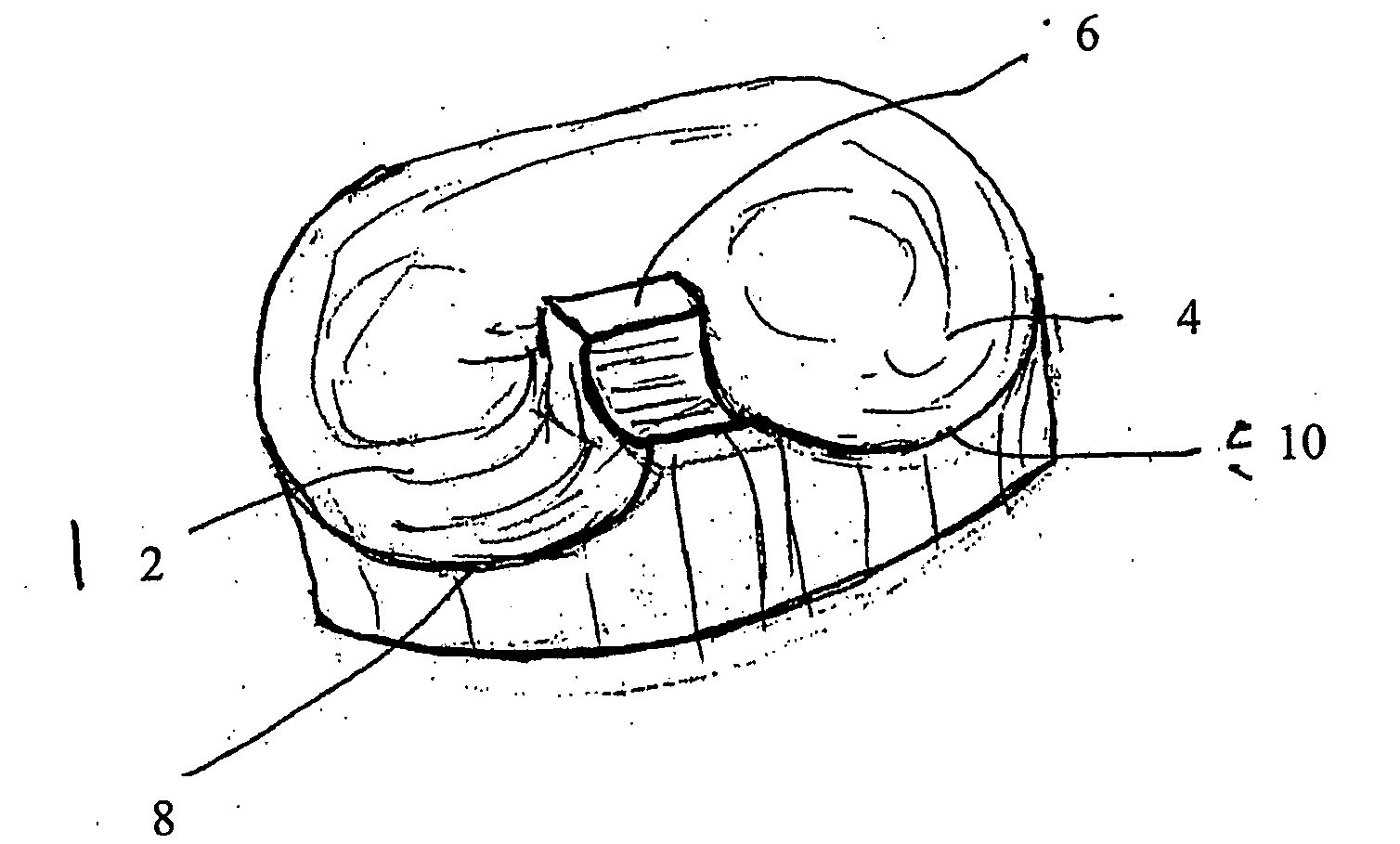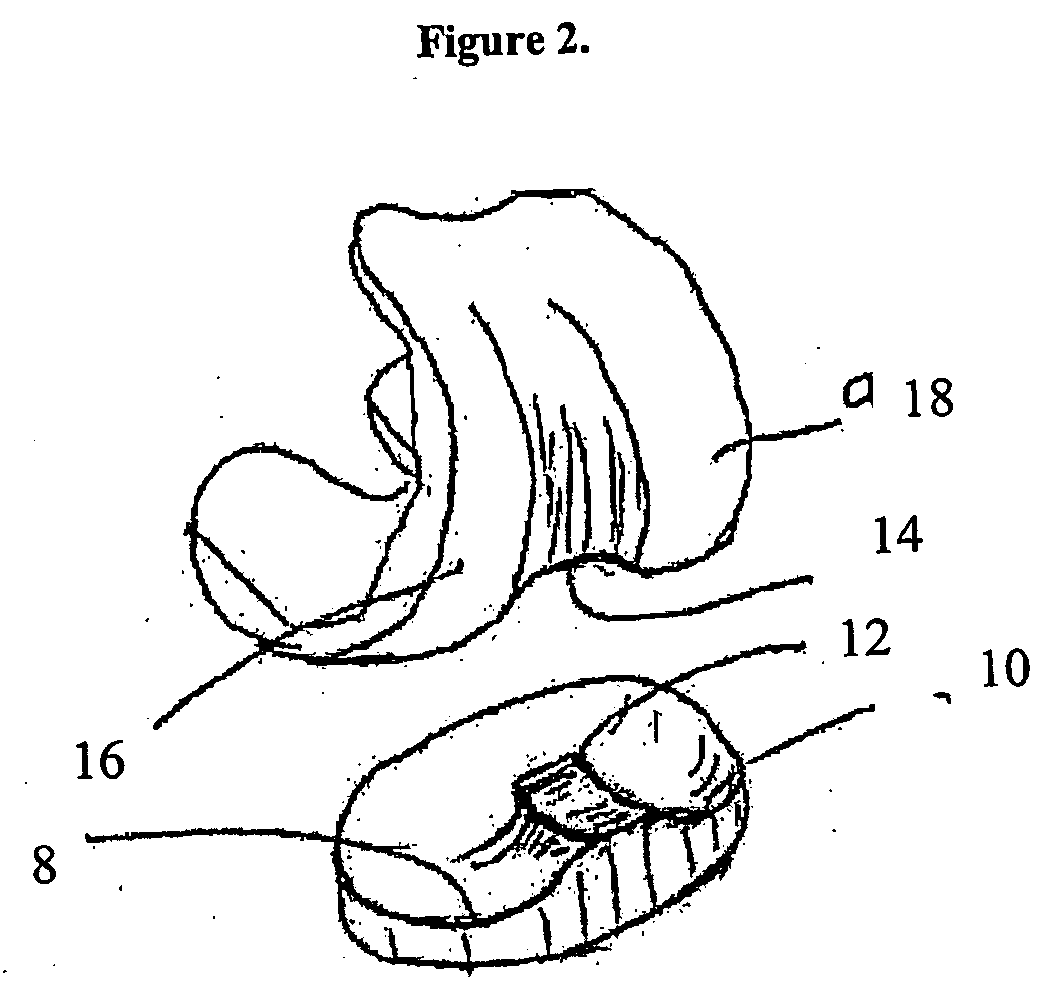Anterior cruciate ligament substituting knee replacement prosthesis
a knee and anterior cruciate ligament technology, applied in the field of knee replacement prosthesis, can solve the problems of affecting the gait and other functional activities of patients, and reducing the strength of the muscles about the knee,
- Summary
- Abstract
- Description
- Claims
- Application Information
AI Technical Summary
Benefits of technology
Problems solved by technology
Method used
Image
Examples
example 1
Bicruciate Substituting (BCS) Total Knee
[0103]An anterior cruciate ligament substituting knee replacement (bicruciate substituting knee, BCS) was designed by a computer assisted design process using solid modeling software. A tibial liner was designed to have a central post with an anterior surface, which was substantially curved in the sagittal and coronal planes. The curvatures of the anterior surface were designed by subtracting the femoral geometry from the tibial post geometry, with the femoral component in various degrees of flexion, desired anterior-posterior translations, and rotations at different degrees of flexion. The desired anterior-posterior translations and rotations were based on in vivo kinematic data determined using a normal knee. A midline location of femoral tibial articular contact in full extension was desirable, while the contact points were posteriorly with increasing knee flexion. This generated a complex surface geometry with varying degrees of radii in b...
example 2
Anterior Cruciate Substituting Knee with an Intact Posterior Cruciate
[0109]An anterior cruciate ligament substituting knee replacement (anterior cruciate substituting knee with an intact posterior cruciate) was designed. A tibial liner was designed with medial and lateral condyles with radii of curvatures slightly larger than the radii of curvatures of the femoral component in the coronal and sagittal planes. A central post was added to the tibial liner with an anterior surface, which was substantially curved in the sagittal and coronal planes. In order to do this, a large box shaped post was added to the tibial liner in the intercondylar region. The femoral component was then placed on the tibial liner with varying degrees of flexion and desired anterior-posterior translations and rotations to simulate the kinematics of the normal knee in flexion. The femoral geometry was then subtracted from the tibial liner post at the different degrees of femoral component position. The curvatur...
example 3
Anterior Cruciate Substituting Knee with an Anterior Femoral Cam and Intact or Absent Posterior Cruciate
[0113]An anterior cruciate ligament substituting knee replacement (anterior cruciate substituting knee with an intact or absent posterior cruciate ligament and an anterior femoral cam) was designed. The tibial liner was deeply dished medial and lateral condyles with radii of curvatures slightly larger than the radii of curvatures of the femoral component in the coronal and sagittal planes. The anterior articular surface of the tibial liner was further elevated to conform with the anterior surface of the femoral component to prevent additional resistance to the anterior translation of the femoral component in mid and late flexion. An anterior cam was added to the femoral component near the trochlear region attaching the medial and lateral femoral condyles anteriorly. A central post was added to the tibial liner with an anterior surface, which was substantially curved in the sagitta...
PUM
 Login to View More
Login to View More Abstract
Description
Claims
Application Information
 Login to View More
Login to View More - R&D
- Intellectual Property
- Life Sciences
- Materials
- Tech Scout
- Unparalleled Data Quality
- Higher Quality Content
- 60% Fewer Hallucinations
Browse by: Latest US Patents, China's latest patents, Technical Efficacy Thesaurus, Application Domain, Technology Topic, Popular Technical Reports.
© 2025 PatSnap. All rights reserved.Legal|Privacy policy|Modern Slavery Act Transparency Statement|Sitemap|About US| Contact US: help@patsnap.com



